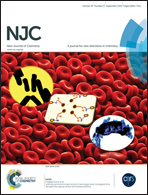Ir nanoparticles-anchored reduced graphene oxide as a catalyst for oxygen electrode in Li–O2 cells
Abstract
Iridium nanoparticles-anchored reduced graphene oxide (Ir-RGO) was prepared by simultaneous reduction of graphene oxide and Ir3+ ions and its catalytic activity for oxygen electrode in Li–O2 cells was demonstrated. Ir particles with an average size of 3.9 nm were uniformly distributed on RGO sheets. The oxygen reduction reaction (ORR) was studied on an Ir-RGO catalyst in non-aqueous electrolytes using cyclic voltammetry and rotating disk electrode techniques. Li–O2 cells with Ir-RGO as a bifunctional oxygen electrode catalyst were subjected to charge–discharge cycling at several current densities. A discharge capacity of 9529 mA h g−1 (11.36 mA h cm−2) was obtained initially at a current density of 0.5 mA cm−2 (393 mA g−1). A decrease in capacity was observed on increasing the current density. Although there was a decrease in capacity on repeated discharge–charge cycling initially, a stable capacity was observed for about 30 cycles. The results suggest that Ir-RGO is a useful catalyst for rechargeable Li–O2 cells.


 Please wait while we load your content...
Please wait while we load your content...